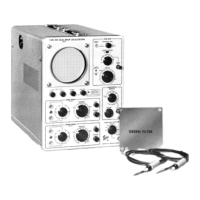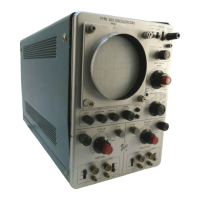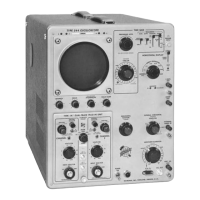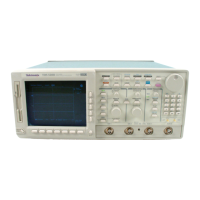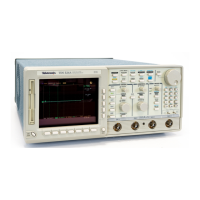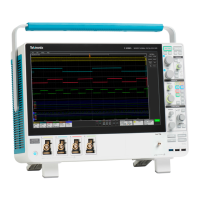System
Maintenance—
51 03N
4.
Check
Instrument
Calibration.
Check
the
calibration
7. Check
Individual
Components.
The
following
of
the
5100-Series
Oscilloscope
and
its
associated
plug-ins,
methods
are provided
for
checking
the
individual
compo-
or check
the affected
circuit if
the
trouble
appears
in one
nents
in the
5100-series
instrument
system.
Components
circuit.
The apparent
trouble
may only be
a
result of
mis-
which
are
soldered
in
place
are best
checked
by
discon-
adjustment
or may be
corrected
by calibration.
Complete
necting
one
end,
isolating
the
measurement
from
the effects
calibration
instructions
are given
in the calibration
section
of
surrounding
circuitry,
of
the
manual
for
each
instrument
in the system.
5. Isolate
the Trouble
to a Circuit.
To isolate
trouble
to
a
particular
circuit, note
the trouble
symptom.
The
symptom often identifies
the circuit
in which
the trouble
is
located.
For example,
poor focus
indicates
that the CRT
circuit (includes high-voltage
supplies)
is probably
at fault.
When
trouble symptoms
appear in more than
one
circuit,
check affected
circuits by taking
voltage and
waveform
readings.
Incorrect operation
of all circuits often
indicates
trouble
in the power
supply. Check first for
correct
voltage of
the
individual
supplies. However,
a defective
component
else-
where in
the instrument can appear
as a power-supply
trouble
and
may also
affect
the operation of
other
circuits.
Table
4-1
lists the tolerances of the
power
supplies
in
this
instrument. These
voltages are measured
between
the
power-supply
test points and ground
on the Power
Supply
circuit board
(see
Fig.
5-1
in the calibration
section of
this
manual for
test point locations). If
a power-supply
voltage
is within
the listed tolerance, the
supply can be
assumed
to
be working
correctly.
If
outside the
tolerance, the
supply
may
be
misadjusted or operating
incorrectly. Use
the pro-
cedure given
in the calibration section
to adjust the power
supplies.
TABLE
4-1
Power Supply Tolerances
Power Supply Tolerance
Typical
Ripple
+205
V
+
180
V
to +240 V
3
V
or
less
+30 V +29.85 V
to +30.15 V
3
mV
or less
+5
V +4.9 V
to
+5.1 V
2 mV
or less
-30
V
-29.925
V
to
-30.075
V
2 mV
or less
6. Check Voltages and Waveforms.
Often the defective
component can be located by checking for
the correct
voltage or waveform in the circuit. Typical voltages
and
waveforms
are
given
on
the diagrams.
NOTE
Voltages
and waveforms
given on the
diagrams
are
not
absolute
and may vary slightly
between
instru-
ments.
To obtain operating
conditions
similar
to
those
used to take these
readings,
see
the first
diagram
page.
A. TRANSISTORS
and INTEGRATED
CIRCUITS
Power
switch
must be
turned off
before
removing
or
replacing
semiconductors.
A good check
of
transistor
operation
is actual perfor-
mance
under
operating
conditions.
A transistor
can
most
effectively
be
checked
by substituting
a
new
component for
it
(or one which
has
been checked
previously).
However, be
sure
that
circuit
conditions are
not such
that
a replacement
transistor
might also be
damaged.
If
substitute
transistors
are
not available,
use a dynamic
tester.
Static-type
testers
are
not recommended,
since they do
not check
operation
under
simulated
operating
conditions.
A suction-type de-
soldering
tool must be
used
to remove
soldered-in
transis-
tors;
see
component
replacement
procedure
for details.
Integrated
circuits
can be
checked
with
a voltmeter,
test
oscilloscope,
or
by direct
substitution.
A good
under-
standing
of
the circuit
description
is essential
to
trouble-
shooting
circuits
using IC's.
Operating
waveforms,
logic
levels,
and
other
operating
information
for
the
IC's are
given
in
the circuit
description
section
of the
appropriate
manual.
Use
care
when
checking
voltages
and waveforms
around
the IC's
so
that
adjacent
leads
are not
shorted
to-
gether.
A
convenient
means of
clipping
a test probe
to the
14—
and 16—
pin
in-line IC's
is with
an
integrated-circuit
test
clip.
This device
also
doubles
as an
extraction
tool.
B. DIODES
A diode
can be checked
for
an open or shorted
con-
dition
by
measuring
the resistance
between
terminals.
With
an
ohmmeter
scale having
an internal
source of between
800
millivolts
and
3
volts,
the resistance
should
be very
high
in one
direction
and very low
when
the
leads
are
reversed.
Do not
use an ohmmeter that has
a high internal
current. High
currents may damage
the diode.
4-4

